Main points
- Competitiveness is not determined by exchange rate policy, except in the short run.
- Competitiveness is determined by the underlying efficency of the economy.
- A strong real exchange rate may be a symbol of more general economic strength.
- Monetary policy aims for monetary stability.
- A fixed exchange rate provides a stable anchor; the inflation rate fluctuates but is bounded.
- Monetary policy should ideally help keep real exchange rate on long-term equilibrium path.
- Floating regimes have not been particularly successful in this.
- Fixed rates may perform just as well, provided there is internal cost-price flexibility.
- Hong Kong possesses this flexibility - contrast Argentina for example.
- Hong Kong may not be significantly uncompetitive at present.
- Overall, criticisms of peg on grounds of competitiveness do not stand up well under scrutiny.
- Not clear that any problems of competitiveness could anyway be resolved by floating.
- Factors contributing to falling prices in Hong Kong have included -
- global slowdown and success in taming inflation
- growing integration of Hong Kong and Mainland economies
- adjustment required under the peg
- cyclical nature of property market.
- There are winners and losers from a falling price level.
- Distinguish deflation of goods and services prices from that of asset prices.
- Economy and society can probably cope with modest falls in prices of goods and services.
- Property prices have been the more volatile and have aroused the greater concern.
- But the peg itself cannot be blamed for more than a small part of property price falls.
- Deflation itself not sufficient reason to alter exchange rate regime.
- Peg appropriate for Hong Kong when it may not be for others, for following reasons -
- internal flexibility
- extreme openness of economy to trade and capital
- commitment not to operate exchange controls
- soundness of financial system.
- Peg functions by clear rule-based discipline.
- Hong Kong is technically equipped to operate other systems.
- But unconvinced that any alternative would be unequivocally superior.
- Floating might be presented as a panacea; but it could also -
- - increase uncertainty, unsettle international confidence, raise risk premium, induce volatility.
- Peg has served well for 18 years and continues to be appropriate for Hong Kong.
* * * * * * *
Introduction
When things aren't going too well, it's natural to look for scapegoats. In the case of the Hong Kong economy, the pegged exchange rate certainly gets its fair share of that treatment. What is the basis for complaints about the peg, and how far are they justified?
Before examining some of the complaints, however, let us review the monetary policy background.
Monetary policy
It is widely accepted that the duty of monetary policy - and that embraces exchange rate policy - is to provide that monetary environment which is most conducive to long-term growth and prosperity of the economy. This is seen to imply a desire for stable monetary conditions, but there is scope for judgement as to how this stability should be defined.
The majority of regimes focus on internal purchasing power and thus aim for low and stable domestic inflation. Thus, the practice of inflation targeting has now become quite widespread and well understood. This requires an active monetary policy, necessarily impacting on domestic interest rates and money market liquidity; and, at least in the strictest form of targeting, it inevitably involves some exchange rate flexibility, even if not an entirely free float.
A minority of regimes, of which Hong Kong is one, focus on a stable external value of the currency - in Hong Kong's case through the particular mechanism and discipline of the currency board. The more externally oriented an economy is, the greater is the weight which may need to be attached to exchange rate stability within the overall concept of monetary stability.
There are various pros and cons of each approach. Inflation targeting is less precise, in that it is necessarily based on forward projections, and verifiable indicators of success are only available after a timelag. It also requires a reasonably accurate forecasting process, which may be simpler to realise in a relatively closed than in a highly open economy. Nevertheless, experience of several countries shows that inflation targeting is capable of delivering good results.
An obvious advantage of a fixed-rate regime is that compliance can be monitored very directly and unambiguously in real time; and, in the currency board version, the regime operates by automatic mechanisms rather than by the discretion of a central bank. It may, however, result in a less stable inflation rate, although, assuming that monetary policy in the country of the anchor currency is conducted responsibly, extremes of hyper-inflation or deflation will be avoided.
Both regimes may be prone to fluctuations in interest rates in response to shocks, but with inflation targeting, which requires a flexible exchange rate even if managed to a degree, the central bank has a measure of discretion in the magnitude and timing of its response, whereas, with a fixed rate, defensive reactions must be more immediate and may hence be potentially sharper.
Hong Kong context
Recent criticisms of Hong Kong's currency board have focused mainly on two aspects - the implications for the competitiveness of Hong Kong vis-a-vis other economies and the problems of living with falling price levels. The remainder of this paper is directed mostly at these issues.
Competitiveness
Changes in competitiveness are typically measured by comparing movements in some appropriate measure of costs or prices at home and abroad, and adjusting for shifts in exchange rates. The measure of competitiveness thus produced is commonly referred to as the real exchange rate1. A stronger real rate means higher relative prices and therefore implies weaker competitiveness2.
I detect two common misconceptions about the real exchange rate.
Influencing the real rate
The first is the belief that the real rate is amenable to control by the central bank or government and that the chosen regime for the nominal exchange rate is therefore an important determinant of the real rate.
Let me explain what I believe to be some flaws in this view.
Even if the central bank could, through intervention in the foreign exchange market or actions to influence domestic interest rates, fix the nominal exchange rate at some particular level, and even if it succeeded in fixing not simply the bilateral rate but the trade-weighted rate, this would only determine the real rate for the short term. This is because any monetary policy actions, such as exchange market intervention or changes in interest rates, in due course have a feedback effect on domestic inflation. More specifically for example, depreciation tends to raise prices. In a market-based economy the central bank, if it already uses monetary policy to set the nominal exchange rate, cannot separately control inflation. Eventually any initial gain in competitiveness from depreciation is offset by the inflationary feedback, most obviously so in highly import-dependent economies such as Hong Kong. Empirical studies do not reject the hypothesis that this feedback is eventually 100%, although the full offset may occur only after a considerable lapse of time.
Meanwhile the real rate is also affected by movements in price levels in other economies, which lie beyond the home central bank's influence.
In sum, the central bank cannot, except perhaps for the short term, dictate the real exchange rate.
Equilibrium of the real rate
The second misconception about the real exchange rate is that a weak rate (if it could somehow be arranged) would necessarily be a good thing, because of the benefit which an improvement in competitiveness, thus measured, would bring to the economy.
History tells a rather different story. Successful economies have typically experienced appreciating exchange rates during periods of their most rapid development; and the wealthiest economies tend to be those which appear to be the most expensive in terms of overall price comparisons. It is not so much the real exchange rate which determines prosperity, as it is the fundamental characteristics of the economy, such as underlying productivity, which determine the real exchange rate. An economy which can successfully sell high value-added goods and services on world markets and as a result enjoy at the same time relatively cheap imports is better off than one which balances its accounts by selling a higher quantity of cheaper output and buying a lower quantity of dearer imports.
There remains a question of whether there might nevertheless be advantage in a short burst of competitive advantage - as might be delivered by an engineered depreciation before the inflationary feedback negated the competitive gains - not just as a means of boosting the economy in the short term but also hopefully as a means of building a better foundation for longer-term growth. Experience suggests, however, that this sort of procedure is a bit like a drug to which the patient too readily becomes addicted. If people come to expect continuing doses of devaluation, then inflation and inflationary expectations may harden and, perhaps more significantly, businesses are spared the discipline of searching for greater efficiency or the incentive to move up-market. The dosage of the drug may be increased as dependency rises, but eventually a fairly severe anti-dote of austerity may need to be administered to break the growing addiction.
It may reasonably be argued, however, that, even if the underlying path of the real exchange rate is determined essentially by structural forces within the economy, monetary policy should be utilised so far as possible to prevent excessive divergences from trend which may prove damaging to the economy. For example, if a currency is artificially strong for a prolonged period, a particular sector of the economy may become so damaged that it is incapable of recovering when the exchange rate eventually returns to equilibrium. In practice, however, it is extremely difficult to determine, at the time, whether a particular movement in the real rate represents a divergence from the equilibrium path or a fundamental shift in the path itself. At various moments over the past 20-30 years there may have been calls for a weaker HK dollar in order to preserve the local manufacturing sector. But few would doubt in retrospect that the shift away from manufacturing to a higher value-added service-based economy has been beneficial and that it would anyway have been inevitable eventually. There would have been little advantage in trying to slow the process through actions of monetary or exchange rate policy.
In other words, the long-term equilibrium path of the real rate is not necessarily flat. The trend path may, at any particular moment, be up, down or flat, while the actual rate constantly diverges from its equilibrium path because of random events such as unforeseen movements in nominal exchange rates or in cost and price levels at home or abroad, or because of the failure of market adjustment processes to work quickly enough.
All of this can be quite aptly illustrated by looking at the path of the Hong Kong dollar's real rate since it was first pegged. The natural trend appeared to be upward, though not smoothly so, for the middle period of about ten years, but there is nothing here which tells us what will, or should, be the path from hereon.
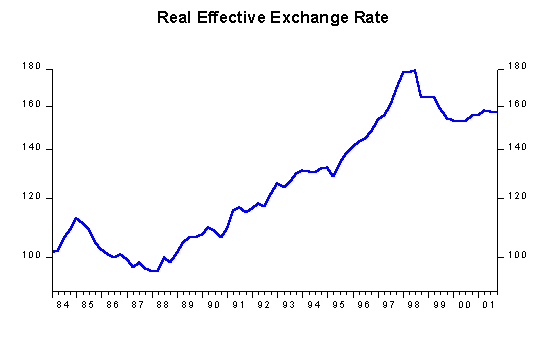
Against this background, monetary policy may not be expected to achieve much for competitiveness. But policy makers nevertheless have to choose. Should a fixed or floating rate be preferred?
Fix or float?
In theory, an advantage of floating is that it may allow for the nominal exchange rate to adjust continuously and precisely so as to keep the real rate at equilibrium - an ideal situation if achievable. However, the historical experience, even of the world's major currencies - US dollar, Japanese yen or the currencies now merged into the euro, for example - is that a floating regime provides no assurance of a stable real rate. In practice, the market does not steer the rate in a continuously rational manner. There is also a tendency, even if the authorities are prepared to conduct some intervention, for floating rates to overshoot occasionally, especially when at the mercy of potentially massive international capital flows and herding behaviour in financial markets. Indeed, in certain circumstances floating may magnify rather than reduce short-run volatility in competitiveness, thereby unsettling the environment for making judgements about costs and prices, and hence for business planning.
The advantage of a fixed rate is that, if credible (and I take Hong Kong's 18-year track record as a leading example of that), it provides an unambiguous and highly transparent real-time indicator of whether monetary policy is on track or not, as well as a solid anchor for planning purposes. But, as with floating, it provides no assurance of a stable real rate. And the disadvantage is that the entire burden of relative cost-price adjustment falls on domestic costs and prices. Inflation is likely to be more volatile than under, say, inflation targeting accompanied by floating. Moreover, notably, the fixed regime may require downward flexibility of costs and prices if the nominal exchange rate becomes too strong for whatever reason. It is this aspect which has become the focal point of recent attention for Hong Kong.
Hong Kong's flexibility
In fact, Hong Kong exhibits very considerable flexibility of the sort required. This is not a characteristic shared to such a degree by many other economies. Comparisons have often been drawn with Argentina because of, until recently, its currency peg. The charts below compare various indicators for Hong Kong and Argentina. The timescales are set to align the sudden loss of competitiveness by Hong Kong in late 1997 because of the Asian crisis, with the sudden loss of competitiveness by Argentina in early 1999 as a result of the Brazilian crisis and devaluation of the real. Attention is drawn in particular to the comparison of developments over the subsequent months (to the right of the vertical divide).
The first chart shows the levels of consumer prices. Hong Kong experienced much more significant price deflation, with the absolute price level falling almost 10% from its peak in the first two years after the shock, while in Argentina prices fell only 3-4%, even looking at a somewhat longer period.
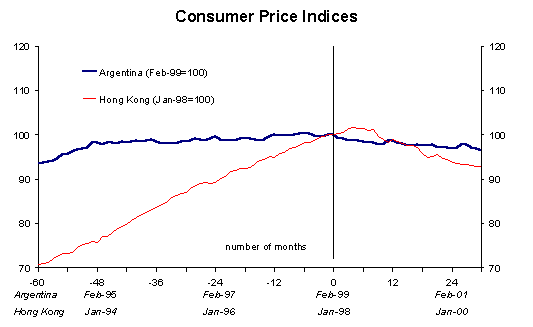
A more appropriate measure of internal costs and prices is the GDP deflator. This fell by some 10% for Hong Kong but was roughly static in Argentina.
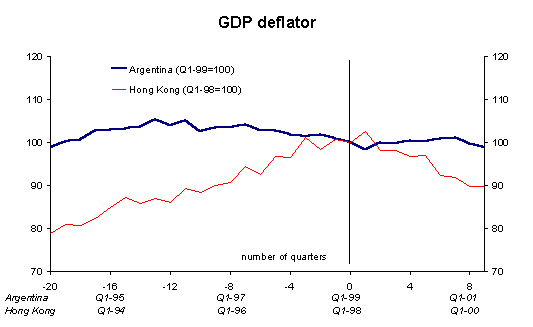
Largely as a result of these differences in the response of internal costs, Hong Kong managed to recoup all of the lost competitiveness (as measured by the real exchange rate), which had amounted to about 15%, but Argentina failed to achieve any lasting recovery; indeed, loss of competitiveness resumed, long before lost ground had been recovered.
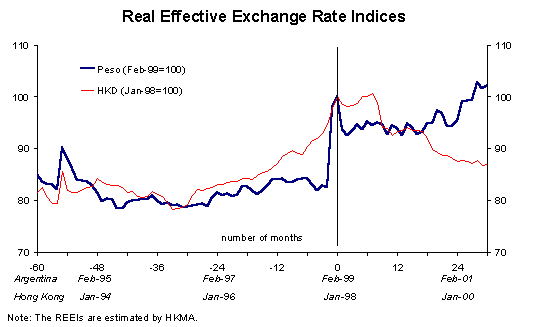
In view of this evident flexibility in Hong Kong, to what extent is it therefore correct to talk of the peg imposing some sort of rigidity on the economy? In the strict sense of the word, there is of course some rigidity, because, even with speedy and flexible adjustments of domestic costs, the correction of these which may be needed to offset a shock to the nominal exchange rate cannot be instantaneous. But if this rigidity is judged against how other economies might or do fare under fixed rates, Hong Kong emerges rather favourably. And, when compared with the alternative of floating, it is by no mean obvious that the peg delivers an inferior result for Hong Kong, given the possibility of volatility or over-shooting under floating, especially for a small and highly exposed economy.
Indeed, although it is always difficult to predict events in hypothetical circumstances, there is a concern that a more flexible regime would, rather than liberating monetary policy, actually pose more problems - especially in the short term as confidence would have to be re-established and might remain more brittle. This might involve higher rather than lower interest rates because of a risk premium, plus greater uncertainty.
Before moving on from the subject of competitiveness, let me leave you with a couple of thoughts. If Hong Kong has, in some underlying sense, been suffering from severe uncompetitiveness, how does one explain the continuing strength of the trade and current account performance …..
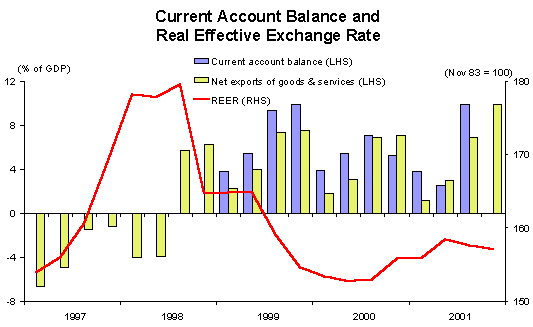
….. and the fact that the pace of recession in Hong Kong over the last two years has not been significantly different from that in a number of other economies in the region?
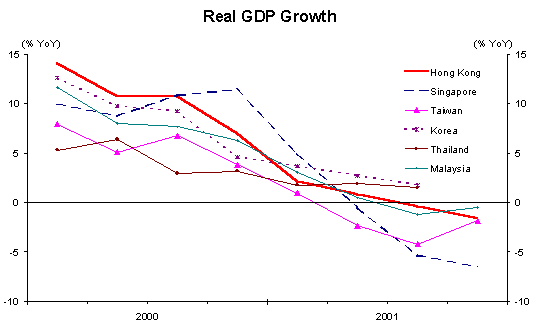
I am drawn to conclude that the criticisms of the peg on competitiveness grounds do not stand up too well under scrutiny. Even if the foregoing analysis and discussion does not prove unequivocally that fixing is superior to floating, it does challenge the contention that perceived problems of competitiveness would dissipate if only we had a floating exchange rate.
Living with deflation
Let me turn now to the other focus of criticism of the monetary regime that I mentioned earlier, namely deflation. There are four main factors which have been contributing to falling prices in Hong Kong.
First, there is the state of the global economy. A combination of recession and remarkable success in taming inflation in recent years have left policy makers in several countries facing the unusual situation of deflation. Hong Kong has not been alone, although the process has perhaps been more prolonged here than in many other places.
The second factor is the process of integration of the economies of Hong Kong and southern China. This is something which is generally welcomed in the broader context, but it may put downward pressure on Hong Kong prices in certain sectors.
The third is the peg which, against the global background mentioned above, has been forcing some downward adjustment of our costs and prices.
The fourth factor is peculiar to the property market, namely the excesses of the property market cycle which drove prices to such peaks some five years ago, from which it was almost inevitable that there would be some correction.
Attitudes to falling prices are, understandably, ambivalent. Other things being equal, consumers, especially those on fixed incomes, generally prefer falling to rising prices. Even some people who have had to suffer small cuts in pay may still be better off than previously; after all, the prices which they face, as measured by Hong Kong's consumer price index, are currently some 14% below their peak. Meanwhile, those involved in marketing Hong Kong as a business location are eager to publicise the lower costs. And prospective first-time entrants to the property market are happy.
But for producers who see continuing declines in the likely prices at which they can sell their output, for wholesalers and retailers whose margins are being squeezed, for home-owners sitting on negative equity, or for financial institutions worried about the solvency of customers as a result of any of these developments, the process of deflation is not particularly welcome.
From the monetary policy perspective, the prospect of persistent deflation presents the possible concern that, even with near-zero interest rates, people may prefer to sit on money balances rather than to spend, and that this may hinder recovery in real activity. To a certain extent the problem may only be illusory. Behaviour should be no different when interest rates are zero and inflation (or, strictly speaking, projected inflation) minus 2%, than when interest rates are 5% and inflation plus 3%; the real rate is the same in each case. But deflation does prevent real interest rates from going negative. It is a matter for debate as to how much of an impediment to recovery this limitation could be. Possibly it would only become significant if the expected pace of deflation was rather sharper than it has been.
In assessing the causes and impact of deflation, and the possible remedies, it is appropriate to distinguish between the price level for goods and services on the one hand, and that for assets - whether financial or real estate - on the other.
For goods and services, the consensus view is probably that a low, stable positive rate of inflation is preferable to a negative one. Nevertheless, both the economy and society may be able to cope for a certain period with modest deflation - in the range of, say, 0-2% pa - without too much difficulty.
Asset prices, on the other hand, display much greater volatility, and the collapse of property prices has created problems for some homeowners and financial institutions, despite presenting opportunities for others. Plainly, stability is preferable to volatility. But the plunge in prices has much more to do with the earlier exuberance, plus structural influences, such as growing cross-border integration, than with the exchange rate.
Although the current deflation may undoubtedly be painful to some, before we rush to argue that deflation could be avoided if only we had a floating exchange rate, let's pause to reflect on the Japanese experience. At times, Japan experienced deflation accompanied by upward pressure on the yen, which only served to exacerbate the deflation. It may not be appropriate to draw too close an analogy, given the contrasting economic circumstances between the two economies, but it is worth noting that, with a fixed exchange rate, deflation, if it continues, eventually restores any lost competitiveness and will then bottom out (assuming no significant continuing deflation overseas). In other words, in the Hong Kong context the peg in effect sets upper and lower bounds to the inflation rate relative to the rate in the United States.
In sum, the peg has certainly not been the only contributor to deflation, and such contribution as it has made, has probably not been severe. The presence of deflation does not itself make a compelling case for altering the exchange rate regime.
Summing up
Back in 1983 when the peg was installed, I recall being asked whether it was the government's intention that the arrangement should be permanent, or in what circumstances a change would be contemplated. I said then simply that the peg was for the time being the most appropriate monetary anchor for Hong Kong. I would give very much the same answer today.
Our peg is not a fixed rate that is supported by or dependent on discretionary intervention. It is a rule-based currency board system which imposes a particular discipline of adjustment through interest rate channels and domestic prices. It enjoys widespread support from international observers both in official circles and more widely. This is not just people being nice to us and choosing not to say anything which might rock the boat, although there may be one or two of them. Rather it reflects an appreciation of the unique features of a currency board structure and the benefits which it has brought over 18 years, as well as an appreciation of the distinctive characteristics of the Hong Kong economy.
The main distinctive characteristics to which I allude are the following: the flexibility in costs and prices, as discussed earlier; the extreme openness of the economy in terms of both trade and capital flows; the constitutional commitment, through the Basic Law, to support the free movement of capital and not to operate exchange controls; and the soundness of the banking sector. Taken together, these factors help explain why a peg may be feasible and sensible for Hong Kong while it might not be so for others.
This does not mean that Hong Kong would be incapable of operating or continuing to prosper under an alternative regime. Indeed, we possess the necessary infrastructure to conduct discretionary monetary policy (although that was not the case back in 1983), and I am confident that my colleagues would be quite capable of meeting the challenge of any new, more activist regime. However, although there may be moments when one thinks "If only we had a floating rate, things wouldn't be so bad right now", one cannot chop and change between regimes to suit short-term expedience. We acknowledge that no system is perfect, but I have suggested that much criticism of the peg may be exaggerated, or even unfounded. We would need to be well satisfied that an alternative would be unequivocally superior, before ditching something which has been the cornerstone of internal financial stability and external confidence for over 18 years.
1 In fact it is necessary to take into account all one's trading partners and thus arrive at the real trade-weighted or "effective" exchange rate - the REER. For ease of exposition, however, only the term "real exchange rate" is used in this paper.
2 The precise interpretation depends crucially on the set of prices or costs which is used in the calculation, but this aspect is not addressed here.







